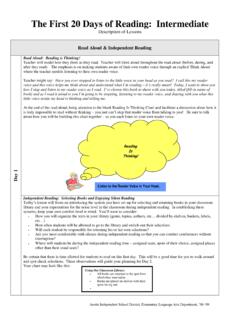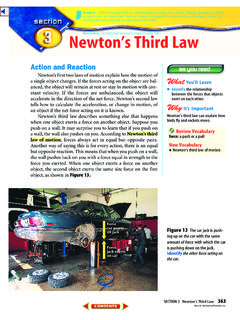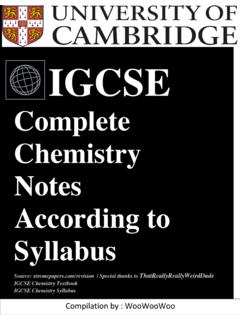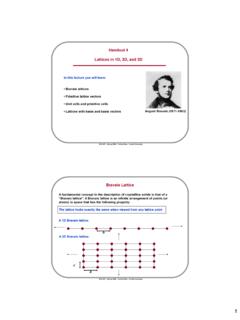Transcription of 8.3.10: Changes of State - centergrove.k12.in.us
1 Thermal Energy and HeatShards of ice fly from the sculptor s chisel. As the crowdlooks on, a swan slowly emerges from a massive block of ice. Asthe day wears on, however, drops of water begin to fall from thesculpture. Drip by drip, the sculpture is transformed into a pud-dle of liquid water. What makes matter change from one State toanother? To answer this question, you need to think about theparticles that make up stated, energy is the ability to do work or causechange. The energy of motion is called kinetic energy. Particleswithin matter are in constant motion. The amount of motion ofthese particles depends on the kinetic energy they possess.
2 Particleswith more kinetic energy move faster and farther apart. Particleswith less energy move more slowly and stay closer total kinetic energy of all the particles in a sample ofmatter is called thermal energy, an extensiveproperty, depends on the number of particles in a substance aswell as the amount of energy each particle has. If either thenumber of particles or the amount of energy in each particlechanges, the thermal energy of the sample Changes . With identi-cally sized samples, the warmer substance has the greater ther-mal energy. In Figure 7,the particles of hot water from the hotspring have more thermal energy than the particles of snow onthe surrounding of State Define and comparethermalenergy and temperature.
3 Relatechanges in thermalenergy to Changes of State . Exploreenergy and temperaturechanges on a Changes State as it heats upor cools Vocabularyenergy:the ability to do work orcause changeNew Vocabulary thermal energy temperature heat melting freezing vaporization condensationFigure 7 These girls are enjoy-ing the water from the hot why the girls appear to becomfortable in the hot spring whilethere is snow on the 2 Changes of State99 Standards : Demonstrate, using drawings and models, the movement of atoms in a solid, liquid, andgaseous State . Explain that atoms and molecules are perpetually in motion. : Explain that increased tem-perature means that atoms have a greater average energy of motion and that most gases expand whenheated.
4 Also covers: (Detailed standards begin on page IN8.)Annie Griffiths Belt/CORBIS100 CHAPTER 4 States of MatterTemperatureNot all of the particles in a sample of matter havethe same amount of energy. Some have more energy than average kinetic energy of the individual particles is thetemperature,an intensive property, of the substance. You can findan average by adding up a group of numbers and dividing thetotal by the number of items in the group. For example, the aver-age of the numbers 2, 4, 8, and 10 is (2 4 8 10) 4 is different from thermal energy because thermalenergy is a total and temperature is an know that the iced tea is colder than the hot tea, asshown in Figure differently, the temperature of iced teais lower than the temperature of hot tea.
5 You also could say thatthe average kinetic energy of the particles in the iced tea is lessthan the average kinetic energy of the particles in the hot a warm object is brought near a cooler object, ther-mal energy will be transferred from the warmer object to thecooler one. The movement of thermal energy from a substanceat a higher temperature to one at a lower temperature is a substance is heated, it gains thermal , its particles move faster and its temperature a substance is cooled, it loses thermal energy, which causesits particles to move more slowly and its temperature to is heat related to temperature?Figure 8 The particles in hot tea move faster thanthose in iced tea.
6 The temperature of hot tea is higherthan the temperature of iced which tea has the higher kinetic of EnergyThermalenergy is one of several dif-ferent forms of forms include thechemical energy in chemicalcompounds, the electricalenergy used in appliances,the electromagnetic energyof light, and the nuclearenergy stored in thenucleus of an atom. Make alist of examples of energythat you are familiar AcademicStandard : Explain that increasedtemperature means that atomshave a greater average energy ofmotion ..Which tea has a lower averagekinetic energy iced tea or hot tea?Amanita PicturesSpecific HeatAs you study more science, you willdiscover that water has many uniqueproperties.
7 One of those is the amountof heat required to increase the temper-ature of water as compared to mostother substances. The specific heat of asubstance is the amount of heat requiredto raise the temperature of 1 g of a sub-stance 1 that have a low specificheat, such as most metals and the sand inFigure 9,heat up and cool down quicklybecause they require only small amountsof heat to cause their temperatures to rise. A substance with a highspecific heat, such as the water in Figure 9,heats up and coolsdown slowly because a much larger quantity of heat is required tocause its temperature to rise or fall by the same Between the Solid and Liquid StatesMatter can change from one State to another when thermalenergy is absorbed or released.
8 This change is known as change ofstate. The graph in Figure 11shows the Changes in temperature asthermal energy is gradually added to a container of the ice in Figure 11isheated, it absorbs thermal energyand its temperature rises. At somepoint, the temperature stops risingand the ice begins to change intoliquid water. The change from thesolid State to the liquid State is temperature at which asubstance Changes from a solid to aliquid is called the melting melting point of water is 0 solids, such as rub-ber and glass, don t melt in the sameway as crystalline solids. Becausethey don t have crystal structures tobreak down, these solids get softerand softer as they are heated, as youcan see in Figure 10 Rather than meltinginto a liquid, glass gradually soft-ens.
9 Glass blowers use this charac-teristic to shape glass intobeautiful vases while it is 2 Changes of State101 Figure 9 The specific heat ofwater is greater than that of energy provided by the Sunraises the temperature of the sandmuch faster than the water.(t)David Weintraub/Stock Boston, (b)James L. Amos/Peter Arnold, 11 VISUALIZING STATES OF MATTER102 CHAPTER 4 States of MatterLike most substances, water can exist in threedistinct states solid, liquid, or gas. At certaintemperatures, water Changes from one stateto another. This diagram shows what Changes occuras water is heated or cooled. TemperatureThermal energyMELTINGWhen ice melts, its temperatureremains constant until all the ice turns towater.
10 Continued heating of liquid watercauses the molecules to vibrate evenfaster, steadily raising the temperature. FREEZINGWhen liquid water freezes, itreleases thermal energy and turns intothe solid State , ice. VAPORIZATIONWhen water reaches itsboiling point of 100 C, water molecules aremoving so fast that they break free of theattractions that hold them together in theliquid State . The result is vaporization the liquid be-comes a gas. The tempera-ture of boiling water remains constantuntil all of the liquid turns to steam. SolidMeltingVaporization0 C100 CFreezingCondensationGasCONDENSATIONWhen steam is cooled,it releases thermal energy and turnsinto its liquid State . This process iscalled condensation.










